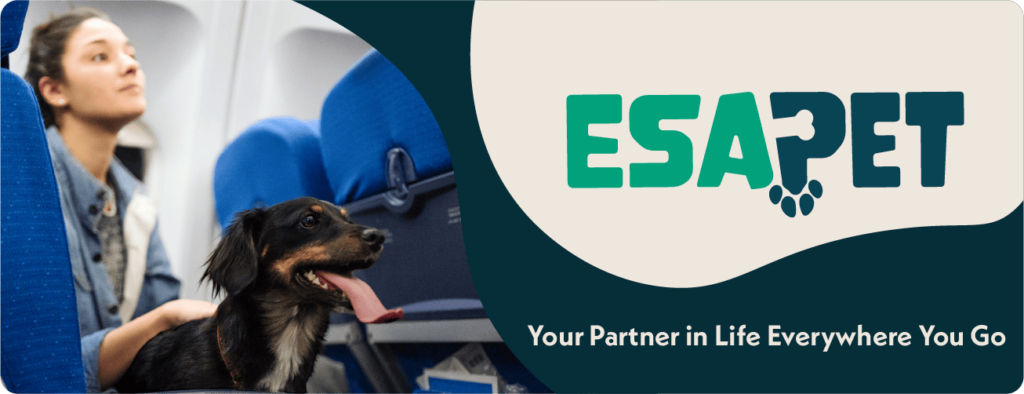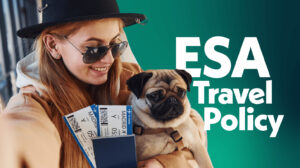Pet Fees for Airlines: What You Need to Know for Traveling With Your Pet

In a world where pets are increasingly being seen as family members, it’s no surprise that more and more pet owners are choosing to bring their furry friends along on their travels. But as many pet parents know, traveling with a pet can be a bit of a wild ride. With a dizzying array of airline policies, fees, and documentation requirements, it can be tough to know where to begin.
Fear not, intrepid pet traveler. This guide has you covered, breaking down the key considerations for a stress-free and safe journey with your beloved pet. So sit back, relax, and let’s get this pet-friendly travel adventure started.
| Airline | Pet Travel Fee | Size Restriction |
|---|---|---|
| Alaska Airlines | $100 in the cabin, varies in cargo | 17″ x 11″ x 7.5″ for hard kennels, 17″ x 11″ x 9.5″ for soft kennels |
| Allegiant Airlines | $50 per leg, per carrier | 9” x 16” x 19” |
| American Airlines | $125 in the cabin, $200 in cargo | 19″ x 13″ x 9″ for all kennels |
| Delta Airlines | $125 – $200 | 21″ x 15″ x 16″ |
| Frontier Airlines | $99 per pet, per leg | No maximum weight |
| Hawaiian Airlines | $35 – $175 in the cabin, $60 – $225 in cargo | 16″ x 10″ x 9.5″ for cabin, 36″ x 25″ x 28″ for cargo |
| JetBlue Airlines | From $100 | 17″ x 12.5″ x 8.5″ |
| Southwest Airlines | $95 per pet carrier | 18.5″ x 8.5″ x 13.5″ |
| Spirit Airlines | $100 | 18″ x 14″ x 9″ |
| United Airlines | $125 per leg | 17.5″ x 12″ x 7.5″ for hard kennels, 18″ x 11″ x 11″ for soft kennels, no crates taller than 30″ for cargo |
Understanding Pet Travel Costs
When it comes to flying with pets, airlines typically offer two options: in-cabin and cargo. In-cabin travel allows smaller pets to accompany their owners in the passenger cabin, usually inside a carrier that fits under the seat. This option is more convenient but comes with its own set of regulations and costs. Some airlines charge a fee for in-cabin pet transport, and there are typically specific size and weight limits for both the pet and the carrier.
Cargo travel is when your pet travels in a special cargo area of the plane, usually with other animals. This is often used for larger animals, and may also have fees associated with it. Many airlines have specific regulations regarding crate dimensions, ventilation, and labeling.
In addition to these costs, there may be other fees for things like the pet carrier or crate, as well as extra baggage charges for larger pets. Also, international flights may have additional requirements and costs, such as health certificates, import permits, and even quarantine periods in some countries. You should research and comply with the rules of both the departure and arrival locations.
Fortunately, there are regulations that protect pet owners. The Air Carrier Access Act (ACAA) requires airlines to accommodate passengers with disabilities, which includes allowing service animals on flights. However, Emotional Support Animals (ESAs) are no longer protected under the ACAA and are now treated as regular pets, with all the same regulations and fees. Although you might be able to fly your pet for free with a PSD Letter, airlines have the final word on whether a pet can travel in the cabin or cargo area, so it’s important to research and plan ahead.
Bring Your Pet Along, AlwaysEnsure Their Company with a PSD Letter |
Airline-Specific Pet Fee Policies
When it comes to pet policies, every airline has its own unique set of rules and regulations. Some charge an arm and a leg for pet travel, while others offer more affordable options. In this section, we’ll be giving you the lowdown on the pet fee policies of the major U.S. airlines, so you can prepare to take your furry friend along on your trip.
Here are the most pet-friendly airlines and a quick run-down of their pet policies:
Alaska Airlines: $100 per pet, cabin-only for dogs, cats, and household birds. Alaska Airlines stands out by allowing a range of animals in the cargo hold, including dogs, cats, guinea pigs, hamsters, birds, reptiles, pigs, rabbits, fish, and ferrets, with the added benefit of Fur-st Class Care for extra assistance.
Allegiant Airlines: $50 per segment per carrier, cabin-only, only dogs and cats allowed. Allegiant Air is noted for being more affordable and lax in pet restrictions, allowing two animals in one carrier if they can comfortably fit.
American Airlines: $125 per pet, cabin-only for dogs and cats, cargo for larger pets for $200. Choose American Airlines if you’re looking for transparency with fees and regulations for traveling with pets.
Delta Airlines: $125 to $200 per pet, cabin-only for pets that fit under the seat in front of you.
Frontier Airlines: $99 per pet per leg, cabin-only, no maximum weight restriction. Frontier Airlines is highlighted as the most affordable for pet airfare, allowing various pets like guinea pigs, hamsters, rabbits, and household birds in the cabin.
Hawaiian Airlines: $125 per pet for dogs and cats less than 25 pounds, only dogs and cats in cabin.
JetBlue Airlines: $100 per pet, cabin-only, with option to purchase a seat for your pet. JetBlue offers a JetPaws service, helping pet owners plan their pet’s travel more seamlessly, and TrueBlue members receive 300 TrueBlue points for every segment they fly with a pet.
Southwest Airlines: $95 per pet carrier, cabin-only, for dogs and cats less than 75 pounds. Consider Southwest Airlines for more affordable in-cabin pet transportation, but be mindful of the limited number of pet carriers allowed per flight.
Spirit Airlines: $100 per pet, cabin-only, no health certificate requirement for pets traveling in the aircraft cabin.
United Airlines: $125 per leg, cabin-only for dogs and cats, call ahead for specific flight rules.
That’s a sneak peek into flying with your pets! Remember, every airline has its own rules, so check ahead and plan accordingly.
Emotional Support Animals (ESA), Service Dogs and ACAA Protection
While ESAs don’t have the same rights as service animals under the Air Carrier Access Act (ACAA), they can still fly in-cabin. However, airlines can enforce restrictions, including advance notice, documentation requirements, and limitations on the number, size, and type of ESAs allowed on a flight.
To travel with your ESA on a plane, you will likely need to provide a letter from a licensed mental health professional dated within one year of your travel date. This letter should state that the ESA is necessary for the passenger’s emotional support, as well as proof of the animal’s health and behavior. While some airlines allow ESAs to travel with their owners in the cabin for free, it’s important to note that many airlines have changed their policies regarding emotional support animals in recent years.
However, thanks to the protection offered by the ACAA, Service Dogs offer various advantages, including free tickets and the option to stay with the owner in the cabin. To enjoy this privilege, you need a PSD Letter signed by a licensed therapist. Also, it’s crucial to contact your airline beforehand, comprehend the procedure, and fill out any required forms to ensure your furry friend or canine companion is allowed on the flight.
Tips for Affordable Pet Travel
Affordable pet travel requires careful planning, research, and budgeting. From vet visits to quarantine requirements, the expenses can add up quickly. However, with careful planning and budgeting, you can make pet travel affordable and enjoyable for both you and your pet. Here are some tips to keep in mind:
1. Research Pet-Friendly Airlines:
- Compare and contrast to find the most budget-friendly option for your pet.
- Consider things such as in-cabin vs. cargo travel, size and weight restrictions, plus any additional fees for pets.
2. Budget for Vet Visits and Health Certificates:
- Schedule a visit to the vet well before your travel date. Some airlines require health certificates issued within a certain timeframe.
- Budget for vaccinations, microchipping, and any other health-related requirements specific to your destination.
3. Explore Affordable Quarantine Options:
- Some destinations may have specific quarantine regulations, so be sure to check the requirements well in advance.
- If your destination requires quarantine for your pet, research affordable and highly rated facilities. Plan ahead to check availability and factor the cost into your travel budget.
- Look into pet insurance options that cover quarantine costs.
4. Consider Implants and Identification:
- Microchipping your pet is not only a safety measure but often a requirement for international travel. Although costly, this one-time investment will ensure your pet’s identification and well-being during the journey.
- Check if your destination country has any specific requirements for pet identification.
5. Pack Wisely to Avoid Extra Fees:
- Use TSA-approved pet carriers or travel crates to avoid delays or extra fees at security.
- Pack efficiently to avoid exceeding baggage weight limits and incurring extra charges.
- Pack medication and vet records in your carry-on, and make sure they’re properly labeled and documented.
6. Check for Pet Insurance Coverage:
- Explore pet insurance options that cover travel-related expenses. While not all policies include travel coverage, some offer protection for unexpected vet visits during your trip.
- Read the terms and conditions of your pet insurance to understand the coverage and any exclusions related to travel.
7. Plan Layovers Strategically:
- Choose layovers that are short and in pet-friendly airports, with comfortable facilities for your pet to stretch their legs and relieve themselves.
- Avoid layovers in extreme weather conditions, as temperature can be a concern for pets in cargo.
- Check if there are any additional fees or restrictions during layovers.
8. Use Pet Travel Apps and Resources:
- Look for pet travel apps and online resources to find pet-friendly hotels, restaurants, and activities along your route.
- Social media groups and forums offer support and tips from fellow pet travelers.
9. Prepare for Potential Emergencies:
- Pack extra food, water, and medication for your pet, just in case of emergencies.
- Research emergency vet clinics along your route, in case of an unexpected medical issue.
- Pack a pet first aid kit with basic supplies like bandages, gauze, and hydrogen peroxide.
Bottom Line: Affordable pet travel is entirely achievable with some strategic planning. From finding low-cost, pet-friendly accommodations to navigating transportation costs and understanding pet policies. Also, in all circumstances be aware of the ancillary costs associated with flying with a pet, including baggage fees, cabin carrier costs, and cargo crate costs.
Lodging Considerations
As pet travel becomes increasingly popular, accommodations are evolving to cater to pet owners’ needs. Gen Z and millennial travelers are particularly driving the demand for pet-friendly lodging, wanting to include their furry friends in their adventures.
While the options for pet-friendly accommodations are expanding, the costs can still be a concern, with extra fees, cleaning charges, and other policies adding to the overall bill.
Here are some things to consider when it comes to costs:
- Pet fees can range from a small one-time charge to a daily or weekly rate, and can vary by hotel chain and location.
- Some hotels may also have restrictions on the type, size, or number of pets allowed.
- Look for hotels that offer amenities specifically for pets, like designated pet areas, treats, and bowls.
- Research reviews to find pet-friendly hotels with a good reputation, and call ahead to confirm pet policies and availability.
- Some hotels may offer discounts for extended stays or loyalty program members with pets.
Expert Tips for Traveling With Pets
Traveling with pets can be an incredibly rewarding experience, but it also comes with its own set of challenges. Here are some expert tips to ensure a smooth journey for both you and your furry friend.
1. Visit the Vet
Before the trip, it’s crucial to ensure your pet is in good health. Schedule a visit to the vet for a general check-up and to update any necessary vaccinations. Your vet may also prescribe medications to help your pet relax during the flight.
2. Pack Essentials
Pack a travel kit with all the essentials your pet will need. This may include food, water, a leash, waste bags, grooming supplies, and any necessary medication. Don’t forget to pack a beloved toy or blanket to give your pet a sense of comfort.
3. Secure Your Pet
Safety should be a top priority when traveling with pets. Use a well-ventilated crate or carrier for your pet that is secure yet comfortable. The carrier should be large enough for your pet to stand, sit, lie down, and turn around in.
4. Keep a Regular Schedule
Try to keep feeding and exercise routines as regular as possible. This can help minimize stress for your pet. Remember to give your pet plenty of water to stay hydrated, especially on long journeys.
5. Research Pet Policies
If you’re staying at a hotel or other accommodation, make sure to check their pet policies beforehand. Some places may have restrictions on the size or breed of pets they allow.
6. Prepare for Emergencies
Have a plan in case of emergencies. This includes knowing the location of the nearest vet in the area you’re traveling to and having a basic pet first-aid kit on hand.
7. Know your Rights
Understanding your rights as a pet owner is important when traveling, and specific regulations support those battling mental health challenges. For some, air travel can be distressing, and having a comforting in-cabin pet companion is the only choice.
Considerations on Traveling With Emotional Support Animals and Service Dogs
When it comes to traveling with ESAs and service dogs, there are some key things to keep in mind. Airlines are required to allow service dogs to travel for free, but ESAs are no longer considered service animals under the Air Carrier Access Act, so they may be subject to pet fees.
Some hotels also differentiate between service animals and ESAs, with different rules and costs associated with each. Documentation requirements for service animals and ESAs can vary by airline or hotel, so it’s important to research and obtain the proper paperwork in advance.Overall, it’s important to stay informed about the latest regulations and guidelines, as these can change frequently.
Get your Official PSD Letter Consultation from a licensed therapist.
Get PSD Letter Now
FAQs on Pet Fees for Traveling with Pets
Are there specific requirements for international pet travel?
Yes, international pet travel requires additional documentation and procedures compared to domestic travel. Each country has its own specific regulations, so it’s important to check the requirements for your destination well in advance. Generally, international pet travel may involve:
- Rabies vaccination certificate
- Health certificate issued by a licensed veterinarian
- Microchip implantation for identification
- Advance notification to the airline and destination country
What is the average cost of a pet carrier?
The cost of a pet carrier can vary depending on factors like size, brand, and features. On average, carriers can range from $30 to $150, with specialized carriers designed for air travel falling within this range. It’s important to invest in a carrier that meets airline requirements, providing both comfort and safety for your pet.
What are the fees associated with flying with a pet in the cabin?
Most airlines charge a fee per pet, per direction. The average cost ranges from $50 to $200 per pet. The fee may vary based on the size of the pet carrier and the weight of your pet. Additional fees may apply for pets traveling internationally, such as import/export fees, quarantine fees, and vaccination requirements.
Do airlines have restrictions on the number of pet carriers allowed on each flight?
Airlines typically have restrictions on the number of pet carriers allowed in the cabin due to limited space. Most flights permit a set number of pets on board, and the number can change depending on the size of the plane. Booking well ahead of time and notifying the airline in advance is the best way to secure a spot for your pet…or pets.
Are there airlines that allow more than one animal in a single carrier?
While most airlines have a strict one pet per carrier policy, there are exceptions. Some smaller pets from the same household may be allowed to share a carrier, as long as they fit comfortably.
Do airlines require health certificates for pets before flying?
Yes, airlines require health certificates for pets before flying. These certificates need to be issued by a licensed veterinarian that confirms your pet is in good health, and its vaccinations are up-to-date.
What is Fur-st Class Care, mentioned in relation to Alaska Airlines?
Fur-st Class Care is Alaska Airlines’ pet-friendly program, designed to provide assistance in arranging a pet’s travel. The service offers dedicated support and amenities providing a stress-free journey for pets and their owners. It also includes personalized guidance, priority handling, and exclusive perks for pets, making the travel experience feel like a first-class adventure.
Do hotels and rental homes charge extra fees for accommodating pets?
Many hotels and rental homes charge extra fees for accommodating pets. These fees can vary widely, ranging from a nominal charge to a fixed amount per night. Additionally, some establishments may impose cleaning fees or refundable deposits to cover potential pet-related damages.
Can an airline seat be purchased for a pet?
While some airlines allow you to purchase a seat for a pet, they are almost always required to travel in a carrier that fits under the seat in front of you or in the cargo hold. This is for safety reasons, as pets can be unpredictable and may cause disruptions in the cabin if not properly contained.
What is the purpose of an identification microchip implanted in pets for travel?
Microchips are a super important tool for keeping pets safe while traveling. They are tiny electronic devices, roughly the size of a grain of rice, that are implanted under a pet’s skin. Each chip contains a unique identification number. When a pet is found, the microchip can be scanned to identify the pet and contact the owner.
Final Thoughts
When traveling with pets, it’s important to start planning early and research all the costs involved. This includes not only the cost of the pet’s transportation, but also things like pet-friendly accommodations, food, medication, and toys. It’s also important to budget for unexpected expenses, as traveling with pets can sometimes be unpredictable.
Preparing your pet for travel by getting them used to their carrier and taking them on shorter trips beforehand can also help reduce stress on travel day. Last but not least, keeping your pet calm and comfortable with plenty of reassurance can make all the difference during the journey. By being prepared, pet travel can be a stress-free and enjoyable experience for both you and your furry friend.
For more information or assistance with flying with your pet, we encourage readers to contact ESA Pet.





